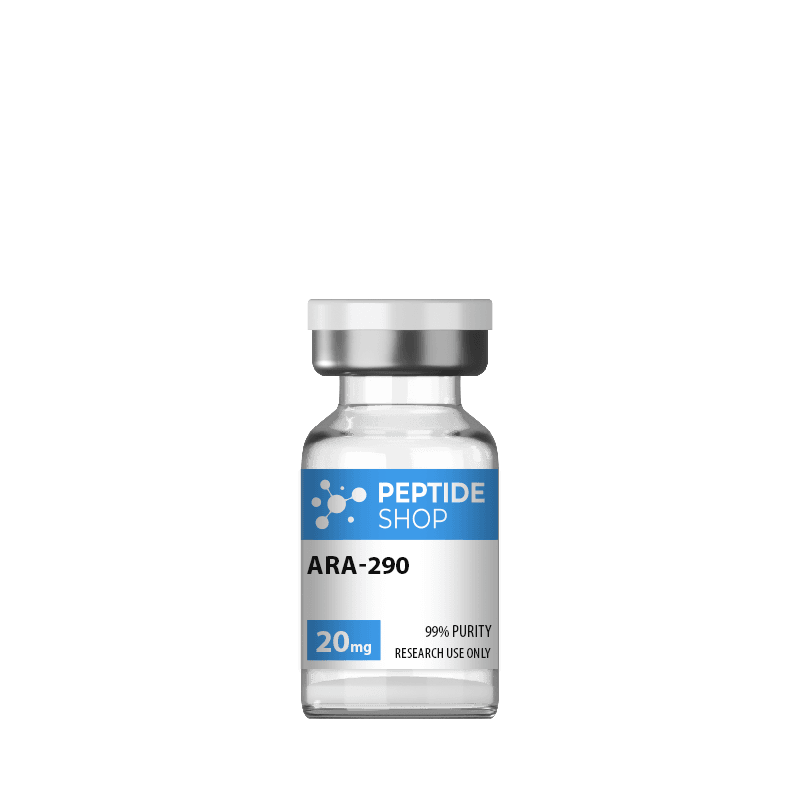Size: 20mg
Contents: ARA-290
Form: Lyophilized powder
Purity: >99%

Size: 20mg
Contents: ARA-290
Form: Lyophilized powder
Purity: >99%
SHARE:
Products sold on our website are designed for in vitro testing and lab experimentation exclusively.
All the products you see on the website are being sold in a lyophilized powder state (freeze-dried), in a sealed sterile vial; and should be reconstituted.
The product’s label clearly states the amount of product a vial contains; some products are offered in different variations.
The products we are selling come in a sealed vial but require additional lab equipment for proper testing.
ARA-290, or cibinetide or helix B surface peptide (HBSP), is a short 11-amino acid peptide derived from erythropoietin (EPO), a naturally occurring protein in the body. While EPO is best known for its application in stimulating red blood cell growth, ARA-290 peptide works differently.
Instead of controlling red blood cell production, this peptide is believed to be involved in tissue regeneration and repair. Scientists think it can show powerful anti-inflammatory and pain-relieving (anti-nociceptive) effects and is interesting for application in various therapies. Utilizing specific attributes of EPO without reducing the levels of blood cells, ARA-290 has the potential to offer new opportunities for healing and recovery.
Scientists believe pain perception is associated with Transient Receptor Potential (TRP) channels, which respond to heat, chemicals, and mechanical stimuli. One specific channel, TRPV1, is believed to trigger pain signals (nociception) by releasing neuropeptides. In 2016, a study suggested that ARA-290 can prevent this process by increasing the threshold for activation of TPRV1, potentially blocking the release of neuropeptides and reducing pain signaling.
To find out more about this, scientists tried experiments with rodents using dorsal root and trigeminal ganglion neurons. Calcium imaging confirmed that the neurons reacted to ARA-290, capsaicin (hot stuff in chili peppers), and KCI. They discovered that the neuron response to capsaicin was significantly inhibited by ARA-290 without affecting any other heat sensor.
Additional analyses with live murine models measured pain sensitivity before and after exposure to capsaicin, both with and without administration of ARA-290. Findings revealed that ARA-290 lowered the sensitivity of the models to capsaicin-included pain, corroborating its efficacy as an analgesic.
Although ARA-290 has not yet been researched, scientists anticipate it may find broader therapeutic uses, including anti-inflammatory and immunomodulatory action. Its selective modulation of TRPV1 channels could open new options for research on pain and inflammation.
Recent study shows that ARA-290 can potentially prevent damage to blood vessels and combat retinal ischemia, which is a main factor of vision loss in ischemic retinopathies. Renewing endothelial colony-forming cells (ECFCs) in the retina is one line of defense against retinal ischemia since ECFCs contribute to vascular restoration.
In rodents with retinal ischemia-induced, researchers tested the effectiveness of ARA-290 by administering it along with ECFC transplantation. Some models received ECFCs alone, while others received ECFCs and ARA-290. The aim was to test whether ARA-290 could improve cell survival under oxidative stress and enhance vascular repair.
Findings showed that while pre-treatment of ECFCs with ARA-290 before transplantation did not significantly improve their ability to restore damaged retinal blood vessels, systemic administration of ARA-290 in mice was encouraging. It appeared to reduce proinflammatory cytokines such as IL-1B and TNF-a retinal tissue, indicating its anti-inflammatory effect. In addition, ECFCs implanted into injured retina blood vessels were found to contribute to the reconstruction of blood flow, with ARA-290 being shown to enhance this to a greater degree than erythropoietin (EPO).
This research hypothesizes that ARA-290 can promote vascular regeneration by minimizing inflammation and promoting ECFC functionality in ischemic retinas. With further work to be performed, the outcomes hold promise as a therapeutic reagent in retinal disease corresponding to impaired blood flow.
A study was conducted to determine whether ARA-290 may have cell-protective and anti-inflammatory properties. More specifically, this research studied peptide potential in PITx models or pancreatic islet transplantation. It had limited success because of islet damage that happens during the isolation process and from the massive inflammatory reactions caused by transplantation.
This study used rodents as test subjects, which scientists used to transplant 180+ pancreatic islet cells. ARA-290 peptide was applied to rodents before, at zero, six and 24 hours after the intervention. After 12 hours of peptide presence, scientists collected and analyzed samples from the liver. Peptide cells seem to show minimal damage to the islets.
This research potentially showed that ARA-290 may have protected the islet cells from subsequent apoptosis and cytokines. Moreover, this peptide appeared to minimize the production of proinflammatory cytokines in the liver after pancreatic islet transplantation, hinting it might mitigate inflammatory responses within the liver.
Based on the clinical trials, the ARA-290 peptide is believed to have the capacity to bind to TPRs, which may help maintain tissue function and protect against harmful inflammation, tissue death, and subsequent cellular. Researchers have pointed out that the main benefit of this peptide over the endogenous erythropoietin cells is its ability to bind TPR receptor cells without affecting muscles or the cardiovascular system.
All of this might help with tissue regeneration and minimize tissue damage while promoting better healing and wound recovery in animal test models.
References:
Useful links